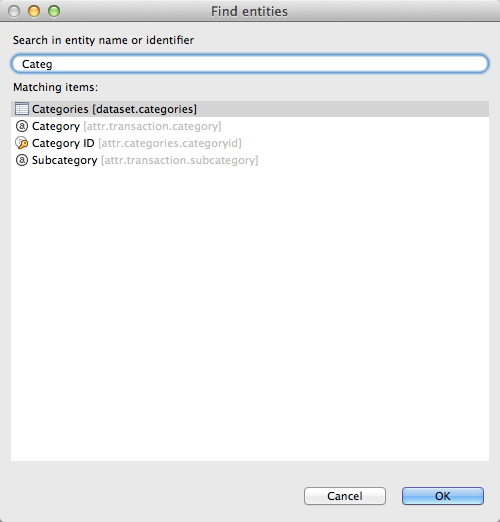CloudConnect Modeler Toolbar and Search
CloudConnect is a legacy tool and will be discontinued. We recommend that to prepare your data you use the GoodData data pipeline as described in Data Preparation and Distribution. For data modeling, see Data Modeling in GoodData to learn how to work with Logical Data Modeler.
If you do not have significant experience with data model or who prefer to learn the application before using it to build, review content in the following order:
- Planning Your Data Model. Regardless of your data modeling experience, every user should review the Planning Your Data Model chapter, which provides an overview of data modeling in CloudConnect and some best practices to designing within the application. See Logical Data Model Components in GoodData.
- Logical Data Model User Interface. Review this chapter to map the content of the previous chapter to the application. See CloudConnect Modeler User Interface.
- Working with Logical Data Models and Working with Objects in Your Data Model. These two chapters provide information on how to work with the content of your data model to manage large-scale changes. See Working with Logical Data Models in CloudConnect and Working with LDM Objects in CloudConnect.
- Tutorial - Creating Your First Data Model. At this point, novice users are ready to step through the tutorial, which covers how to build the logical data model for a simple Human Resources application. See Creating Your First Data Model in CloudConnect.
CloudConnect Resources
The following resources are available to assist you in getting you up and running with CloudConnect.
CloudConnect Training
GoodData University offers a range of instructor-led online training classes, including multiple offerings on the CloudConnect Designer.
Visit the GoodData University.
CloudConnect Documentation
The following documentation resources are available for CloudConnect Designer, ETL, and the CloudConnect projects fed by the data.
Resource | Description | Link |
|---|---|---|
CloudConnect | General documentation on the CloudConnect Designer and related platform components. | Loading Data Using CloudConnect |
CloudConnect LDM Modeler | Documentation on the LDM Modeler component of the CloudConnect Designer. | |
Data Integration Console | Documentation on Data Integration Console and Process management | |
MAQL DDL documentation | Developer articles on the Data Definition Language version of MAQL, which is used for defining logical data models |
Searching the Data Model Using the LDM Modeler
Through the LDM Modeler, you can search the currently opened model file for specific entities.
To search for model entities, click the Search icon (
) in the toolbar. You may also press CTRL/COMMAND + F.As you type in the Find Entities window, the LDM Modeler begins displaying matches between your entry the current model file.
- Search terms are matched against the display name or the internal identifier of entities in the data model file.
- Matches are valid against any part of the name or identifier, instead of just the start of them.
- Model files opened in other tabs are not searched.
You may search for the following types of entities: datasets, facts, attributes, connection points, and date dimensions.
To search for all examples of a type of entity, enter the first segment of the internal identifier of these types. For example, to search for all attributes, enter attr.
You cannot search for the following: labels, hyperlinks, or foreign keys.
